《基因工程》习题及参考答案
- 格式:doc
- 大小:100.50 KB
- 文档页数:23
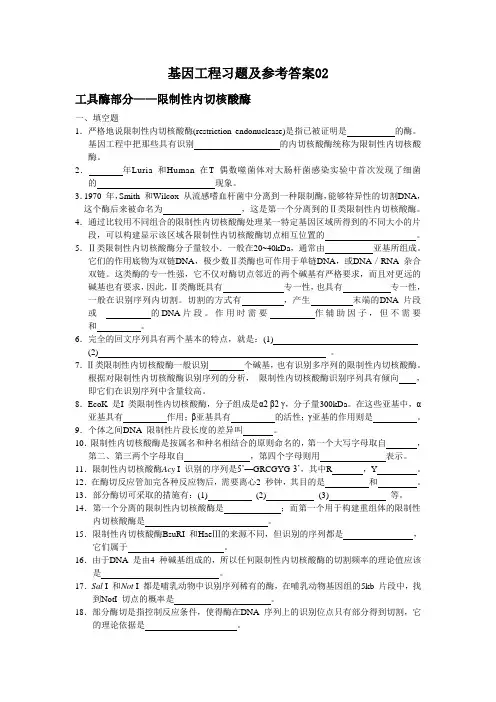
基因工程习题及参考答案02工具酶部分——限制性内切核酸酶一、填空题1.严格地说限制性内切核酸酶(restriction endonuclease)是指已被证明是的酶。
基因工程中把那些具有识别的内切核酸酶统称为限制性内切核酸酶。
2.年Luria 和Human 在T 偶数噬菌体对大肠杆菌感染实验中首次发现了细菌的现象。
3.1970 年,Smith 和Wilcox 从流感嗜血杆菌中分离到一种限制酶,能够特异性的切割DNA,这个酶后来被命名为,这是第一个分离到的Ⅱ类限制性内切核酸酶。
4.通过比较用不同组合的限制性内切核酸酶处理某一特定基因区域所得到的不同大小的片段,可以构建显示该区域各限制性内切核酸酶切点相互位置的。
5.Ⅱ类限制性内切核酸酶分子量较小.一般在20~40kDa,通常由亚基所组成。
它们的作用底物为双链DNA,极少数Ⅱ类酶也可作用于单链DNA,或DNA/RNA 杂合双链。
这类酶的专一性强,它不仅对酶切点邻近的两个碱基有严格要求,而且对更远的碱基也有要求,因此,Ⅱ类酶既具有专一性,也具有专一性,一般在识别序列内切割。
切割的方式有,产生末端的DNA 片段或的DNA片段。
作用时需要作辅助因子,但不需要和。
6.完全的回文序列具有两个基本的特点,就是:(1)(2) 。
7.Ⅱ类限制性内切核酸酶一般识别个碱基,也有识别多序列的限制性内切核酸酶。
根据对限制性内切核酸酶识别序列的分析,限制性内切核酸酶识别序列具有倾向,即它们在识别序列中含量较高。
8.EcoK 是I 类限制性内切核酸酶,分子组成是α2 β2 γ,分子量300kDa。
在这些亚基中,α亚基具有作用;β亚基具有的活性;γ亚基的作用则是。
9.个体之间DNA 限制性片段长度的差异叫。
10.限制性内切核酸酶是按属名和种名相结合的原则命名的,第一个大写字母取自,第二、第三两个字母取自,第四个字母则用表示。
11.限制性内切核酸酶Acy I 识别的序列是5’—GRCGYG-3’,其中R ,Y 。

生物学中的生物技术应用与生物医学研究进展生物技术是一门综合性学科,涉及生物学、化学、物理学、计算机科学等多个领域。
在生物学中,生物技术应用广泛,主要包括基因工程、细胞工程、酶工程和蛋白质工程等。
生物医学研究进展则主要涉及生物医药、生物材料、生物诊断和生物治疗等方面。
以下是生物学中生物技术应用与生物医学研究进展的详细介绍:1.基因工程:基因工程是通过体外DNA重组和转基因等技术,赋予生物以新的遗传特性,创造出更符合人们需要的新的生物类型和生物产品。
基因工程在农业、医学、环境保护等领域具有重要意义。
2.细胞工程:细胞工程旨在研究和应用细胞生物学原理,通过细胞培养、细胞融合、核移植等技术,实现细胞株、细胞系的建立和生物制品的生产。
细胞工程在生物制药、疾病模型研究等方面具有重要应用。
3.酶工程:酶工程是利用生物化学和分子生物学的原理,对酶进行改造和应用的研究领域。
酶工程在食品工业、洗涤剂、制药等领域具有广泛应用。
4.蛋白质工程:蛋白质工程是通过基因修饰或基因合成,对现有蛋白质进行改造,或制造一种新的蛋白质,以满足人类生产和生活需求。
蛋白质工程在药物开发、生物材料等领域具有重要意义。
5.生物医药:生物医药是指运用生物技术手段研发的药物和治疗方法,包括重组蛋白质药物、抗体药物、基因治疗药物等。
生物医药在治疗肿瘤、遗传病、传染病等方面具有重要应用。
6.生物材料:生物材料是指用于生物体内或与生物体相接触的materials,具有生物相容性、生物可降解性和生物活性等特点。
生物材料在医学、生物学、化学等领域具有重要应用。
7.生物诊断:生物诊断是指利用生物学、化学和分子生物学技术,对生物样品进行定性、定量分析,以检测和诊断疾病。
生物诊断技术在临床医学、疾病预防、健康管理等方面具有重要意义。
8.生物治疗:生物治疗是指利用生物制品或生物技术手段,对疾病进行治疗的方法。
生物治疗包括免疫治疗、基因治疗、细胞治疗等,广泛应用于癌症、遗传病、免疫系统疾病等领域。
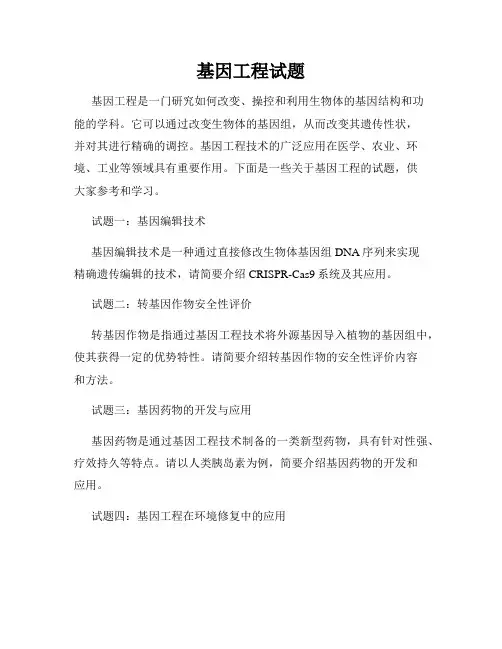
基因工程试题基因工程是一门研究如何改变、操控和利用生物体的基因结构和功能的学科。
它可以通过改变生物体的基因组,从而改变其遗传性状,并对其进行精确的调控。
基因工程技术的广泛应用在医学、农业、环境、工业等领域具有重要作用。
下面是一些关于基因工程的试题,供大家参考和学习。
试题一:基因编辑技术基因编辑技术是一种通过直接修改生物体基因组DNA序列来实现精确遗传编辑的技术,请简要介绍CRISPR-Cas9系统及其应用。
试题二:转基因作物安全性评价转基因作物是指通过基因工程技术将外源基因导入植物的基因组中,使其获得一定的优势特性。
请简要介绍转基因作物的安全性评价内容和方法。
试题三:基因药物的开发与应用基因药物是通过基因工程技术制备的一类新型药物,具有针对性强、疗效持久等特点。
请以人类胰岛素为例,简要介绍基因药物的开发和应用。
试题四:基因工程在环境修复中的应用基因工程技术在环境修复中有着重要地位,可以利用生物体修复受到污染的土壤、水体等环境。
请以重金属污染土壤修复为例,简要介绍基因工程在环境修复中的应用。
试题五:基因工程在动物育种中的应用基因工程技术在动物育种中有着广泛的应用,可以加速优良基因的传播和培育出具有特定优势的新品种。
请以瘦肉型猪育种为例,简要介绍基因工程在动物育种中的应用。
试题六:基因工程伦理问题基因工程技术的发展也带来了一系列伦理问题,如基因改造的人类是否具有平等的生存权利等。
请简要讨论基因工程伦理问题,并提出你自己的观点。
试题七:基因工程在抗疾病治疗中的前景基因工程技术在抗疾病治疗中具有广阔的前景,包括基因治疗、基因诊断等。
请简要介绍基因工程在抗疾病治疗中的前景和应用。
试题八:基因工程与传统育种的比较基因工程技术与传统育种方法相比,具有许多优势和特点。
请以粮食作物的改良为例,比较基因工程技术和传统育种方法在作物改良中的差异和优势。
以上是关于基因工程的一些试题,希望能够帮助你了解和学习基因工程技术的相关知识。
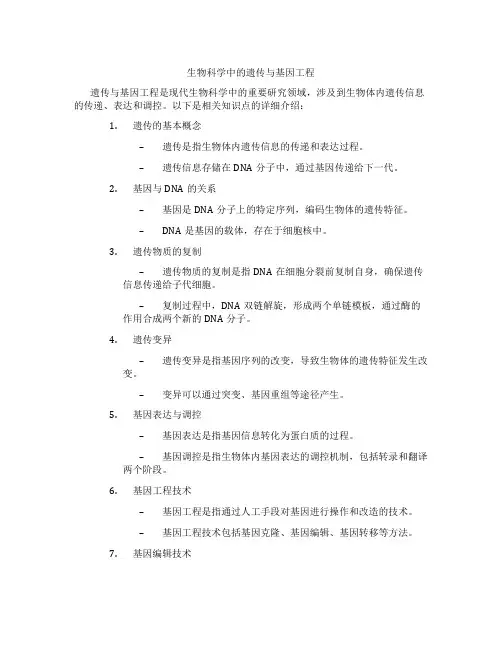
生物科学中的遗传与基因工程遗传与基因工程是现代生物科学中的重要研究领域,涉及到生物体内遗传信息的传递、表达和调控。
以下是相关知识点的详细介绍:1.遗传的基本概念–遗传是指生物体内遗传信息的传递和表达过程。
–遗传信息存储在DNA分子中,通过基因传递给下一代。
2.基因与DNA的关系–基因是DNA分子上的特定序列,编码生物体的遗传特征。
–DNA是基因的载体,存在于细胞核中。
3.遗传物质的复制–遗传物质的复制是指DNA在细胞分裂前复制自身,确保遗传信息传递给子代细胞。
–复制过程中,DNA双链解旋,形成两个单链模板,通过酶的作用合成两个新的DNA分子。
4.遗传变异–遗传变异是指基因序列的改变,导致生物体的遗传特征发生改变。
–变异可以通过突变、基因重组等途径产生。
5.基因表达与调控–基因表达是指基因信息转化为蛋白质的过程。
–基因调控是指生物体内基因表达的调控机制,包括转录和翻译两个阶段。
6.基因工程技术–基因工程是指通过人工手段对基因进行操作和改造的技术。
–基因工程技术包括基因克隆、基因编辑、基因转移等方法。
7.基因编辑技术–基因编辑是指通过特定的酶切酶识别和切割DNA序列,实现对基因的精确修改。
–CRISPR/Cas9是近年来发展起来的一种基因编辑技术,具有高效率和易于操作的特点。
8.基因转移与转基因生物–基因转移是指将外源基因导入生物体的细胞中,并使其表达出来。
–转基因生物是指通过基因转移技术导入外源基因的生物体,可以改变其遗传特征和性状。
9.遗传病与基因治疗–遗传病是由基因突变引起的疾病。
–基因治疗是指通过基因转移技术将正常的基因导入病变细胞,修复基因功能,治疗遗传病。
10.遗传资源的利用与保护–遗传资源是指生物体内的遗传信息,包括基因、物种和生态系统等。
–遗传资源的利用与保护是生物科学中的重要议题,涉及到生物多样性的维护和可持续利用。
以上是关于生物科学中遗传与基因工程的知识点介绍,供您参考。
习题及方法:1.习题:请解释遗传信息是如何在DNA复制过程中传递给子代细胞的。
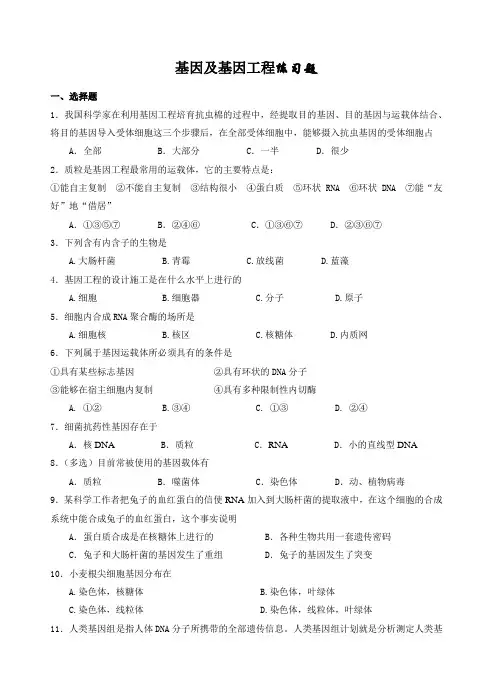
基因及基因工程练习题一、选择题1.我国科学家在利用基因工程培育抗虫棉的过程中,经提取目的基因、目的基因与运载体结合、将目的基因导入受体细胞这三个步骤后,在全部受体细胞中,能够摄入抗虫基因的受体细胞占A.全部B.大部分C.一半D.很少2.质粒是基因工程最常用的运载体,它的主要特点是:①能自主复制②不能自主复制③结构很小④蛋白质⑤环状RNA ⑥环状DNA ⑦能“友好”地“借居”A.①③⑤⑦B.②④⑥C.①③⑥⑦D.②③⑥⑦3.下列含有内含子的生物是A.大肠杆菌B.青霉C.放线菌D.蓝藻4.基因工程的设计施工是在什么水平上进行的A.细胞B.细胞器C.分子D.原子5.细胞内合成RNA聚合酶的场所是A.细胞核B.核区C.核糖体D.内质网6.下列属于基因运载体所必须具有的条件是①具有某些标志基因②具有环状的DNA分子③能够在宿主细胞内复制④具有多种限制性内切酶A. ①②B.③④C. ①③D. ②④7.细菌抗药性基因存在于A.核DNA B.质粒C.RNA D.小的直线型DNA 8.(多选)目前常被使用的基因载体有A.质粒 B.噬菌体C.染色体D.动、植物病毒9.某科学工作者把兔子的血红蛋白的信使RNA加入到大肠杆菌的提取液中,在这个细胞的合成系统中能合成兔子的血红蛋白,这个事实说明A.蛋白质合成是在核糖体上进行的 B.各种生物共用一套遗传密码C.兔子和大肠杆菌的基因发生了重组 D.兔子的基因发生了突变10.小麦根尖细胞基因分布在A.染色体,核糖体B.染色体,叶绿体C.染色体,线粒体D.染色体,线粒体,叶绿体11.人类基因组是指人体DNA分子所携带的全部遗传信息。
人类基因组计划就是分析测定人类基因组的核苷酸序列。
其主要内容包括绘制人类基因的遗传图、物理图、序列图和转录图。
工作艰巨可见一斑。
科学家应对多少染色体进行分析A.46条B.24条C.23条D.22条12.基因治疗是把健康的外源基因导入A.有基因缺陷的细胞中B.有基因缺陷的染色体中C.有基因缺陷的细胞器中D.有基因缺陷的DNA分子中13.下列不属于获取目的基因的方法是A.“鸟枪法”B.转录法C.反转录法D.根据已知氨基酸序列合成法14.用“鸟枪法”提取目的基因的步骤为①用限制性内切酶将供体细胞DNA切成许多片段②将许多DNA片段分别载入运载体③选取目的基因片段插入运载体④通过运载体转入不同的受体细胞⑤让供体DNA片段在受体细胞内大量繁殖⑥找出带有目的基因的细胞,并分离出目的基因A.①③④⑤⑥B.①②④⑤⑥C.①②③④⑤⑥D.①②③④⑤15.关于真核细胞基因结构的表达中,正确的是A.不同基因中外显子的碱基对在整个基因碱基对中所占比例很大B.外显子所含碱基对一般多于内含子C.内含子是不能转录,不能编码蛋白质的序列D.非编码区对基因的表达起调控作用16.有关基因工程的叙述正确的是A.限制性内切酶只在获得目的基因时才用B.重组质粒的形成在细胞内完成C.质粒都可以作为运载体D.蛋白质的结构可为合成目的基因提供资料17.细胞核基因与细胞质基因相比,相同的是A.载体B.数目C.分离时机D.随机分离18.植物学家将胡萝卜的韧皮部细胞分离出来,将单个细胞放入特定培养基中培养,获得了许多完整的植株,这些植株的特点是A.彼此性状极为相似B.都是单倍体植株C.植株的变异频率较高D.都是纯合体植株19.控制细菌合成抗生素的基因、控制放线菌主要性状的基因、控制病毒抗原特异性的基因依次在①核区大型环状DNA ②质粒上③细胞染色体上④衣壳内核酸上A.①③④B.①②④C.②①③D.②①④20.基因工程中常作为基因的运载体的一组结构是A.质粒、线粒体、噬菌体B.染色体、叶绿体、线粒体C.质粒、噬菌体、动植物病毒D.细菌、噬菌体、动植物病毒21.科学家已能运用基因工程技术,让羊合成并分泌抗体。
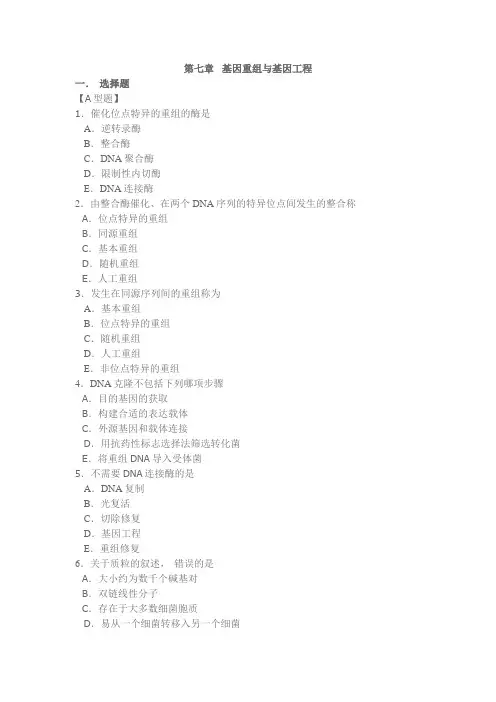
第七章基因重组与基因工程一.选择题【A型题】1.催化位点特异的重组的酶是A.逆转录酶B.整合酶C.DNA聚合酶D.限制性内切酶E.DNA连接酶2.由整合酶催化、在两个DNA序列的特异位点间发生的整合称A.位点特异的重组B.同源重组C.基本重组D.随机重组E.人工重组3.发生在同源序列间的重组称为A.基本重组B.位点特异的重组C.随机重组D.人工重组E.非位点特异的重组4.DNA克隆不包括下列哪项步骤A.目的基因的获取B.构建合适的表达载体C.外源基因和载体连接D.用抗药性标志选择法筛选转化菌E.将重组DNA导入受体菌5.不需要DNA连接酶的是A.DNA复制B.光复活C.切除修复D.基因工程E.重组修复6.关于质粒的叙述,错误的是A.大小约为数千个碱基对B.双链线性分子C.存在于大多数细菌胞质D.易从一个细菌转移入另一个细菌E.常带抗药基因7.某限制性内切核酸酶切割5'…GG▼AATTCC…3'序列后产生A.5'突出末端B.3'突出末端C.5'及3'突出末端D.5'或3'突出末端E.平末端8.限制性核酸内切酶识别序列的特点是A.超螺旋结构B.α螺旋结构C.回文结构D.锌指结构E.串联重复序列9.cDNA文库包括该种生物A.全部遗传信息B.所有蛋白质的编码基因C.某些蛋白质的编码基因D.rRNA基因E.tRNA基因10.不能用作克隆载体的DNA是A.质粒DNAB.噬菌体DNAC.细菌基因组DNAD.腺病毒DNAE.逆转录病毒DNA11.常用质粒载体的特点是A.为线性双链DNA分子B.为环型单链DNA分子C.具有自我复制能力D.含有同一限制性内切酶的多个切点E.缺乏表达外源基因的能力12.基因克隆载体应具备的基本条件是A.含有耐药基因B.具备表达调控元件C.具有转录能力D.具有翻译能力E.具有自我复制能力13.关于建立cDNA文库的叙述,错误的是A.从特定组织中提取mRNAB.从特定组织中提取DNAC.用逆转录酶合成与mRNA互补的单股DNAD.用DNA聚合酶,以单股cDNA为模板合成双链cDNA E.双链cDNA与适当载体连接14.基因工程中不需要A.限制性内切酶B.基因载体C.DNA连接酶D.末端核苷酸转移酶E.核酶15.连接目的基因与载体不能采用A.粘端连接B.平端连接C.同聚物加尾连接D.人工接头连接E.非共价键连接16.在DNA重组中,催化形成重组DNA分子的酶是A.DNA聚合酶B.逆转录酶C.解链酶D.DNA连接酶E.拓扑异构酶17.不属于回文结构的双链DNA序列(仅列出其中一条链序列)是A.AGAATTCTB.TGAATTCAC.GGAATTCCD.CGTTAAGCE.AGATATCT【X型题】18.DNA重组的步骤包括A.用PCR技术合成大量的重组DNAB.将外源性DNA与载体连接C.将重组DNA引入受体细胞D.培养细胞以扩增重组DNAE.筛选出含有重组体的克隆19.关于限制性内切酶的叙述,正确的是A.一类能识别单链DNA中特定碱基顺序的核酸水解酶B.大部分Ⅱ类酶识别的DNA序列呈二元旋转对称C.酶切产生的末端是粘性末端或平末端D.不同的限制性内切酶酶切产生的末端不同E.辨认的核苷酸序列一般为4或6 个核苷酸20.关于质粒DNA的叙述,正确的是A.是基因组DNA的组成部分B.具有独立复制功能C.含有目的基因D.具有限制性内切酶酶切位点E.含有抗生素抗性基因21.载体必需具备的特点是A.本身是一个复制单位,具有复制起点B.插入外源DNA不影响载体本身的复制C.进入细胞后用自身酶系进行复制D.易进入受体细胞E.易于鉴定和筛选22.载体和目的基因的连接效率最高而且是定向连接的A.两个不同的粘性末端B.两个相同的粘性末端C.一个粘性末端和一个平端D.两个酶切产生的平端E.两个由粘性末端补平产生的平端23.同聚物加尾连接法连接目的基因与载体需要A.核酶B.限制性核酸内切酶C.末端核苷酸转移酶D.DNA连接酶E.DNA拓扑异构酶24.在分子克隆中,目的DNA可来自A.原核细胞染色体DNAB.真核细胞染色体DNAC.真核细胞mRNA反转录的cDNAD.聚合酶链式反应E.人工合成的DNA二、名词解释1. DNA cloning2. 限制性核酸内切酶3. Gene library三、简答题1. 在基因克隆中,目的基因有哪些主要来源?2. 常用的限制性核酸内切酶有哪些特点?3. 连接目的基因与载体的方式主要有哪些?4. 简述基因克隆的基本过程5. 理想的基因克隆载体应具有哪些条件?质粒为什么能作为基因载体?参考答案一.选择题1.B 2.A 3.A 4.B 5.B 6.B 7.A 8.C 9.C 10.C 11.C 12.E 13.B 14.E 15.E 16.D 17.D 18.BCDE 19.BCE 20.BDE 21.ABDE 22. AC 23.CD 24.ABCDE二、名词解释1. DNA克隆又称基因克隆或重组DNA。

复习题1 (包括分子生物学基础知识)(请各位同学将所有题目翻译成英文后再做!)一、解释下列名词1.Gene manipulation2.Promotor3.Cloning:4.Subcloning二、填空题:将下列各题空缺部分的答案填在后面的方框内,两者用“;”隔开。
1.基因操作(Gene manipulation)的核心部分是基因克隆(gene cloning), gene cloning的基本要点有(),()和()。
2.()是遗传物质的基木单位,也是作为遗传物质的核酸分子上的一段片段。
它可以是连续的,也可以是();可以是(),也可以是RNA;可以存在于染色体上,也可以()3.基因操作并不是一个法律概念,除了包括基因克隆外,还包括基因的()、()、()和()等与基因研究相关的内容。
4.启动子(Promo(or)是指()。
通常一个Gene是否表达,()是关键的一步,是起决定作用的。
在转录过程屮,Promoter还是()的结合位点。
5.原核生物的RNApolymerase主要由两部分组成:()和(),其屮。
■因子并不参与RNA 的合成,它的作用主要是()。
6.从()到()的这一段距离称为一个转录单位,或者一个转录产物,其屮可包括一个或者多个Gene。
7.转录终止子主要有两种,一种是(),另一种是()。
8.重叠基因(Overlapping gene)是指(),间隔基因(Interrupted gene)是指()三、选择题:从备选答案中选出正确的结果,正确答案是唯一的。
四、简答题:1.简述基因克隆的两个基本特征?参考答案:基因克隆的两个基本特征是一是强调外源核酸分子(一般情况下都是DNA)在不同宿主屮的繁殖,打破自然种的界限将来自于不相关物种的基因放入一个宿主中是基因操作的一个重要特征,基因操作的另一个重要特征是繁殖。
2.什么是gene cloning ?什么是亚克隆(subcloning) ?参考答案:基因克降:一定程度上等同于基因的分离,即从复杂的生物体基因组中,经过酶切,消化等步骤,分离带有目的基因的DNA片段。
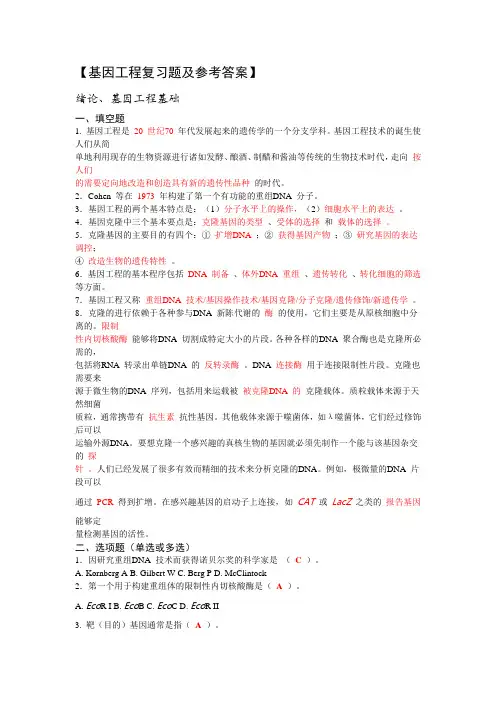
【基因工程复习题及参考答案】绪论、基因工程基础一、填空题1. 基因工程是20 世纪70 年代发展起来的遗传学的一个分支学科。
基因工程技术的诞生使人们从简单地利用现存的生物资源进行诸如发酵、酿酒、制醋和酱油等传统的生物技术时代,走向按人们的需要定向地改造和创造具有新的遗传性品种的时代。
2.Cohen 等在1973 年构建了第一个有功能的重组DNA 分子。
3.基因工程的两个基本特点是:(1)分子水平上的操作,(2)细胞水平上的表达。
4.基因克隆中三个基本要点是:克隆基因的类型、受体的选择和载体的选择。
5.克隆基因的主要目的有四个:①扩增DNA ;②获得基因产物;③研究基因的表达调控;④改造生物的遗传特性。
6.基因工程的基本程序包括DNA 制备、体外DNA 重组、遗传转化、转化细胞的筛选等方面。
7.基因工程又称重组DNA 技术/基因操作技术/基因克隆/分子克隆/遗传修饰/新遗传学。
8.克隆的进行依赖于各种参与DNA 新陈代谢的酶的使用,它们主要是从原核细胞中分离的。
限制性内切核酸酶能够将DNA 切割成特定大小的片段。
各种各样的DNA 聚合酶也是克隆所必需的,包括将RNA 转录出单链DNA 的反转录酶。
DNA 连接酶用于连接限制性片段。
克隆也需要来源于微生物的DNA 序列,包括用来运载被被克隆DNA 的克隆载体。
质粒载体来源于天然细菌质粒,通常携带有抗生素抗性基因。
其他载体来源于噬菌体,如λ噬菌体,它们经过修饰后可以运输外源DNA。
要想克隆一个感兴趣的真核生物的基因就必须先制作一个能与该基因杂交的探针。
人们已经发展了很多有效而精细的技术来分析克隆的DNA。
例如,极微量的DNA 片段可以通过PCR 得到扩增。
在感兴趣基因的启动子上连接,如CAT 或LacZ 之类的报告基因能够定量检测基因的活性。
二、选项题(单选或多选)1.因研究重组DNA 技术而获得诺贝尔奖的科学家是(C )。
A. Kornberg AB. Gilbert WC. Berg PD. McClintock2.第一个用于构建重组体的限制性内切核酸酶是(A )。
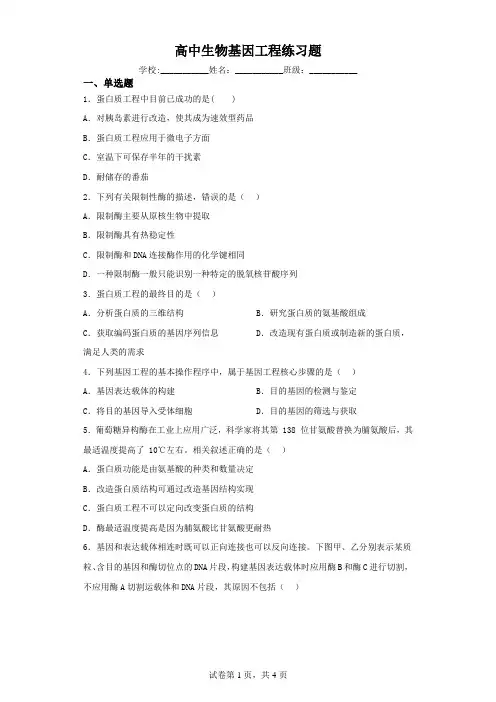
高中生物基因工程练习题学校:___________姓名:___________班级:___________一、单选题1.蛋白质工程中目前已成功的是( )A.对胰岛素进行改造,使其成为速效型药品B.蛋白质工程应用于微电子方面C.室温下可保存半年的干扰素D.耐储存的番茄2.下列有关限制性酶的描述,错误的是()A.限制酶主要从原核生物中提取B.限制酶具有热稳定性C.限制酶和DNA连接酶作用的化学键相同D.一种限制酶一般只能识别一种特定的脱氧核苷酸序列3.蛋白质工程的最终目的是()A.分析蛋白质的三维结构B.研究蛋白质的氨基酸组成C.获取编码蛋白质的基因序列信息D.改造现有蛋白质或制造新的蛋白质,满足人类的需求4.下列基因工程的基本操作程序中,属于基因工程核心步骤的是()A.基因表达载体的构建B.目的基因的检测与鉴定C.将目的基因导入受体细胞D.目的基因的筛选与获取5.葡萄糖异构酶在工业上应用广泛,科学家将其第 138 位甘氨酸替换为脯氨酸后,其最适温度提高了 10℃左右。
相关叙述正确的是()A.蛋白质功能是由氨基酸的种类和数量决定B.改造蛋白质结构可通过改造基因结构实现C.蛋白质工程不可以定向改变蛋白质的结构D.酶最适温度提高是因为脯氨酸比甘氨酸更耐热6.基因和表达载体相连时既可以正向连接也可以反向连接。
下图甲、乙分别表示某质粒、含目的基因和酶切位点的DNA片段,构建基因表达载体时应用酶B和酶C进行切割,不应用酶A切割运载体和DNA片段,其原因不包括()A.防止目的基因和运载体发生反向连接B.保证构建的重组质粒中含有标记基因C.防止目的基因或运载体重新自身环化D.保证构建的重组质粒中含有启动子7.关于基因工程和下图所示黏性末端的叙述,正确的是()A.①与③是由相同的限制酶切割产生的B.DNA连接酶可催化①与③的连接C.经酶切形成④需要脱去2分子水D.基因工程中常用的工具酶有限制性核酸内切酶、DNA连接酶和运载体8.DNA琼脂糖凝胶电泳的分子筛效应是指作为支持介质的琼脂糖,具有网络结构,使大分子物质在通过时受到较大阻力,借此分离不同大小的DNA片段。
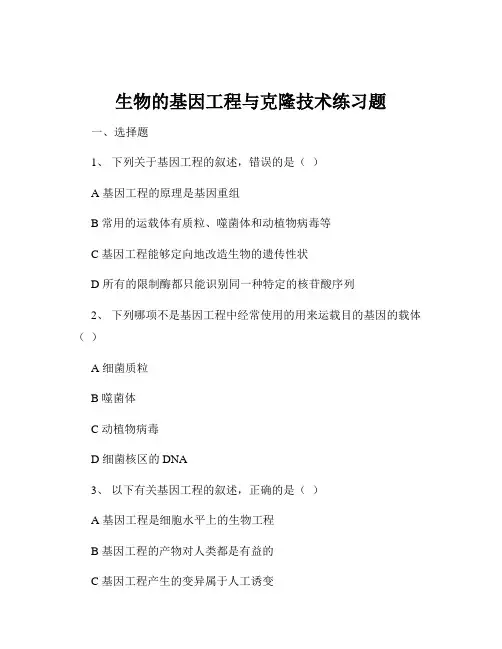
生物的基因工程与克隆技术练习题一、选择题1、下列关于基因工程的叙述,错误的是()A 基因工程的原理是基因重组B 常用的运载体有质粒、噬菌体和动植物病毒等C 基因工程能够定向地改造生物的遗传性状D 所有的限制酶都只能识别同一种特定的核苷酸序列2、下列哪项不是基因工程中经常使用的用来运载目的基因的载体()A 细菌质粒B 噬菌体C 动植物病毒D 细菌核区的 DNA3、以下有关基因工程的叙述,正确的是()A 基因工程是细胞水平上的生物工程B 基因工程的产物对人类都是有益的C 基因工程产生的变异属于人工诱变D 基因工程育种的优点之一是目的性强4、科学家们经过多年的努力,创立了一种新兴的生物技术——基因工程,实施该工程的最终目的是()A 定向提取生物体的 DNA 分子B 定向地对 DNA 分子进行人工“剪切”C 在生物体外对 DNA 分子进行改造D 定向地改造生物的遗传性状5、下列关于基因工程的叙述,正确的是()A 基因工程经常以抗生素抗性基因为目的基因B 细菌质粒是基因工程常用的运载体C 通常用一种限制酶处理含目的基因的 DNA,用另一种限制酶处理运载体 DNAD 为育成抗除草剂的作物新品种,导入抗除草剂基因时只能以受精卵为受体6、下列不属于克隆技术的是()A 一小块胡萝卜经组织培养,发育成完整的胡萝卜植株B 将人的 DNA 片段植入细菌体内后获得大量人的 DNA 片段C 农业生产上利用马铃薯的芽繁殖马铃薯D 小羊多利的诞生7、利用克隆技术培育良种牛时,如果多个供体细胞来自同一头牛,培育出的多个牛犊个体在性状上也不完全相同,分析其原因,下列叙述不正确的是()A 性状变异可由环境条件引起B 基因可能会发生突变C 受体细胞的细胞质基因不同D 细胞核基因发生了重组8、下列关于克隆技术的叙述中,错误的是()A 20 世纪末克隆技术已经成熟B 克隆技术具有广阔的应用前景C 克隆技术可能会带给人类许多负面影响D 克隆实际上是一种无性生殖方式9、下列关于克隆羊多利的叙述,错误的是()A 多利的诞生证明了高度分化的动物细胞具有全能性B 多利的诞生运用了细胞核移植技术C 提供细胞核的母羊对多利的性状起主要作用D 多利的诞生说明动物细胞的细胞核具有全能性10、下列有关克隆人的说法错误的是()A 克隆人是一种无性生殖方式B 克隆人违反了人类伦理道德C 克隆人会导致人类基因库的单一性D 克隆人有利于保持人类的优良基因二、填空题1、基因工程是在________水平上进行的遗传操作。
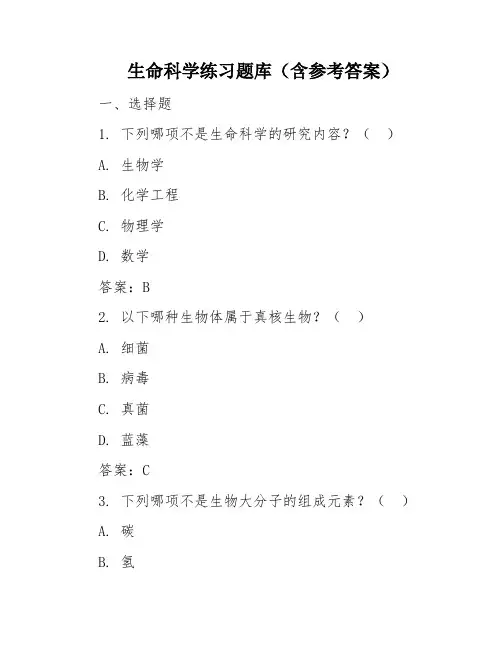
生命科学练习题库(含参考答案)一、选择题1. 下列哪项不是生命科学的研究内容?()A. 生物学B. 化学工程C. 物理学D. 数学答案:B2. 以下哪种生物体属于真核生物?()A. 细菌B. 病毒C. 真菌D. 蓝藻答案:C3. 下列哪项不是生物大分子的组成元素?()A. 碳B. 氢C. 氧D. 钾答案:D4. 以下哪种细胞器是负责蛋白质合成的?()A. 线粒体B. 核糖体C. 内质网D. 高尔基体答案:B5. 以下哪种现象不属于细胞信号转导?()A. 细胞膜上的受体与配体结合B. 细胞内第二信使的产生C. 蛋白质磷酸化D. 细胞分裂答案:D6. 以下哪种生物技术属于基因工程?()A. 发酵工程B. 酶工程C. 细胞工程D. 克隆技术答案:D7. 以下哪种生物技术属于细胞工程?()A. 发酵工程B. 酶工程C. 基因工程D. 克隆技术答案:D8. 以下哪种生物技术属于酶工程?()A. 发酵工程B. 酶工程C. 细胞工程D. 克隆技术答案:B9. 以下哪种生物技术属于发酵工程?()A. 发酵工程B. 酶工程C. 细胞工程D. 克隆技术答案:A10. 以下哪种生物技术属于组织培养技术?()A. 发酵工程B. 酶工程C. 细胞工程D. 克隆技术答案:C二、填空题1. 生命科学是研究__________和__________的科学。
答案:生命现象、生命活动规律2. 生物大分子主要包括__________、__________、__________等。
答案:蛋白质、核酸、糖类3. 细胞信号转导包括__________、__________、__________等过程。
答案:受体与配体结合、细胞内第二信使的产生、蛋白质磷酸化4. 基因工程的基本操作步骤包括__________、__________、__________、__________等。
答案:目的基因的获取、基因表达载体的构建、目的基因的导入、目的基因的检测与鉴定5. 克隆技术包括__________、__________、__________等。
生物技术练习题库(含答案)一、单选题(共52题,每题1分,共52分)1.对活的微生物进行计数的最准确的方法是()A、显微镜直接计数B、干细胞重量测定C、平板菌落计数D、比浊法正确答案:C2.为蛋白质生物合成中肽链延伸提供能量的是A、ATPB、CTPC、GTPD、UTP正确答案:C3.半乳糖苷酶显色反应法中含有外源DNA重组克隆的菌落颜色是( )。
A、白色B、蓝色C、透明色D、红色正确答案:A4.细菌学的奠基人是()。
A、柯赫B、安东尼·列文虎克C、路易·巴斯德D、李斯特正确答案:A5.紫外线的穿透力低,仅适用于()的灭菌。
A、表面灭菌B、无菌室空间C、培养间空间D、A+B+C正确答案:D6.要将土壤中自生固氮菌与其它杂菌分离开来,应将它们接种在()A、不含氮源,不含杀菌剂的培养基B、加入氮源,加入杀菌剂的培养基上C、加入氮源,不含杀菌剂的培养基上D、不含氮源,加入杀菌剂的培养基上正确答案:A7.下列耐热能力最强的是()A、营养细胞B、芽孢C、菌丝D、孢子正确答案:B8.真菌中发现的唯一的几丁质物质存在于()中。
A、细胞质B、线粒体C、细胞壁D、孢子正确答案:C9.涂布平板法常用的接种量是()mLA、1B、2C、0.5D、0.1正确答案:D10.大多数霉菌细胞壁的主要成份是()A、几丁质B、肽聚糖C、纤维素D、磷壁酸正确答案:A11.酿酒酵母的无性繁殖是:( )A、裂殖B、菌丝断裂繁殖C、子囊孢子繁殖D、芽殖正确答案:D12.固体培养基在()℃融化A、60B、50C、96D、45正确答案:C13.酵母菌适宜的生长pH值为()A、4.0-6.0B、6.5~8.0C、<4.0D、7.0-7.5正确答案:A14.血浆蛋白质的种类不正确的是A、盐析法可分血清为清蛋白和球蛋白B、随着分离方法不同有不同数量的蛋白质C、醋酸纤维膜电泳血清可分为5种蛋白质D、一种蛋白质正确答案:D15.下列生理过程中,释放能量最多的是()A、葡萄糖氧化分解为二氧化碳和水B、葡萄糖分解为酒精和二氧化碳C、葡萄糖分解为甘油D、葡萄糖分解为乳酸正确答案:A16.配制固体培养基的正确顺序为()①溶化②调pH③加棉塞④包扎⑤培养基的分装⑥称量A、⑥①②⑤④③B、①②⑤④⑥③C、⑥①②⑤③④D、①②⑥⑤③④正确答案:C17.糖类最主要的生理功能是( )A、软骨的基质B、细胞膜组分C、提供能量D、免疫作用正确答案:C18.无菌制剂的配料用水使用( )A、饮用水B、去离子水C、注射水D、纯化水正确答案:C19.组成病毒粒子核心的化学物质是( )A、蛋白质B、脂肪C、糖类D、核酸正确答案:D20.高丰度血浆蛋白是A、心肌球蛋白B、病毒蛋白C、免疫球蛋白D、生长因子正确答案:C21.L-ASP是一种( )氨基酸。
高中生物《生物技术与工程》练习题(附答案解析)学校:___________姓名:___________班级:__________一、单选题1.矿山废弃地生态修复工程的关键是()A.植被恢复和土壤微生物群落的重建B.选择合适的养殖动物以增加物种多样性C.优先选择农作物以提高经济效益D.尽可能依靠自然演替恢复其生态功能2.下列属于生态工程特点的是()A.多投资、少效益、可持续B.少效益、可持续、高消耗C.少消耗、高效益、可持续D.少消耗、高效益、多投资3.设计生态工程的常用方法之一是给食物链(网)“加环”,下图就是一种“加环”示意图,据图判断下列说法错误的是()A.用玉米的副产品玉米芯生产木糖醇,可增加经济效益B.用残渣来培育食用菌和蛆蛹,实现了物质的多级利用C.图中的箭头可表示物质循环和能量流动D.该生态工程的运转离不开人的管理4.进行生态工程建设时,不但要考虑到自然生态系统的规律,更重要的是要考虑到经济和社会等系统的影响力。
这说明建设生态工程时应遵循的原理是()A.整体原理B.协调原理C.自生原理D.循环原理5.我国赤峰市元宝山矿区生态恢复工程是矿区废弃地生态恢复工程的实例,除煤矿外,金矿、铁矿等也存在很多的废弃地需要进行矿区生态恢复工程建设。
这些生态恢复工程中最重要的内容都是()A.矿区布局规划B.停止矿物开采C.改良土壤,恢复植被D.隔离重建,综合利用6.我国古代先民依据“无废弃物农业”(如图)保证了土壤的肥力,改善了土壤结构,培育了土壤微生物。
下列有关描述正确的是()A.植物可以吸收微生物分解粪肥产生的色氨酸合成生长素B.人类选择会诱导农作物发生高产变异,使其朝着一定的方向进化C.无物理化学生物等外来因素影响时,农作物的性状会稳定遗传D.“无废弃物农业”体现了生态工程的循环原理7.下列实例与主要体现的生态工程基本原理,匹配最恰当的是()A.中国传统农业——自生原理B.在养分稀少的深海有物种丰富的珊瑚礁——循环原理C.太湖中水葫芦泛滥——协调原理D.水乡的桑基鱼塘——整体原理8.下列有关叙述,错误的是()A.水体污染和水资源短缺是目前全球性的环境问题B.人口少的地区生态足迹小C.在应用植物修复技术治理被重金属污染的土壤时,需要选择符合要求的多种植物,这遵循了自生和协调原理D.“四位一体”农业生态工程中,往往将蔬菜棚与猪圈连通起来提高经济效益,这遵循了循环和整体原理9.下列有关生态工程实例的叙述不正确的是()A.我国在西部地区实行退耕还林还草工程,这属于大区域生态系统恢复工程B.在对城市进行规划和布局时,要进行城市生态分区C.在生态工程建设时,应积极利用自然生态系统的强大自我恢复力,节省投资D.我国生态工程的应用范围比发达国家小,也不那么强调经济效益10.重金属污染指由重金属及其化合物造成的环境污染,主要由采矿、废气排放、污水灌溉和使用重金属超标制品等人为因素所致。
第二章 DNA重组克隆的单元操作练习题噬菌体载体(练习题)一、填空题1.噬菌体之所以被选为基因工程载体,主要有两方面的原因:一是;二是。
2.第一个报道的全测序的单链DNA 噬菌体是φX174,DNA 长5386 个碱基对,共个基因,为一环状DNA 分子,基因组的最大特点是。
3.λ噬菌体的基因组DNA 为kb,有多个基因。
在体内,它有两种复制方式,扩增时(早期复制)按复制,成熟包装(晚期复制)则是按复制。
它有一个复制起点,进行向复制。
λ噬菌体的DNA 既可以以线性存在又可以环状形式存在,并且能够自然成环。
其原因主要是在λ噬菌体线性DNA 分子的两端各有一个个碱基组成的天然黏性末端。
这种黏性末端可以自然成环。
成环后的黏性末端部位就叫做位点。
4.根据噬菌体的包装能力,将野生型λ噬菌体的基因组DNA 改造成插入型载体,该载体的最小分子大小约为kb,插入的外源片段最大不超过kb。
5.野生型的M13 不适合用作基因工程载体,主要原因是和。
6.黏粒(cosmid)是质粒—噬菌体杂合载体,它的复制子来自、COS 位点序列来自,最大的克隆片段达到kb。
7.有两类改造型的λ噬菌体载体,即插入型和取代型。
从酶切点看,插入型为个,取代型为个。
8.野生型的丸噬菌体DNA 不宜作为基因工程载体,原因是:(1) (2) (3) 。
9.M13 单链噬菌体的复制分为三个阶段:(1) (2) (3) 。
10.噬菌粒是由质粒和噬菌体DNA 共同构成的,其中来自质粒的主要结构是,而来自噬菌体的主要结构是。
11 .M13 单链噬菌体基因2 和基因4 之间的IG 区有三个最重要的功能,即(1)(2) (3) 。
12.野生型的M13 有10 个基因,分为三个功能集团,其中与复制有关的两个基因是:和。
13.以λ噬菌体载体和黏粒载体构建文库时,起始DNA 的长度是不同的,前者为kb,后者为kb。
14.λ噬菌体载体由于受到包装的限制,插入外源DNA 片段后,总的长度应在噬菌体基因组的的范围内。
基因工程同步练习第一卷:选择题一、单择题1.有关基因工程的叙述正确的是()A.限制酶只在获得目的基因时才用B.重组质粒的形成是在细胞内完成的C.质粒都可作为载体D.蛋白质的结构成分为合成目的基因提供资料2.基因工程常用的受体有()①大肠杆菌②枯草杆菌③支原体④动植物细胞A.①②③④B.①②③C.②③④D.①②④3.下列哪项不是基因工程中经常使用的用来运载目的基因的载体()A.细菌质粒B.噬菌体C.动植物病毒D.细菌核区的DNA4.基因工程是在DNA分子水平上进行设计施工的。
在基因操作的基本步骤中,不进行碱基互补配对的是()A.人工合成目的基因B.目的基因与运载体结合C.将目的基因导入受体细胞D.目的基因的检测表达5.不是基因工程方法生产的药物是()A.干扰素B.白细胞介素C.青霉素D.乙肝疫苗6.在基因工程中,切割载体和含有目的基因的DNA片段中,需使用()A.同种限制酶B.两种限制酶C.同种连接酶D.两种连接酶7.在基因工程中用来修饰改造基因的工具是()A.限制酶和连接酶B.限制酶和水解酶C.限制酶和运载酶D.连接酶和运载酶8.下列哪项叙述不是运载体必须具备的条件()A.具有某些标记基因B.决定宿主细胞的生存C.能够在宿主细胞中复制D.有多个限制酶切点9.正确表示基因操作“四部曲”的是()A.提取目的基因→目的基因导入受体细胞→目的基因与运载体的结合→目的基因的检测和表达B.目的基因的检测和表达→提取目的基因→目的基因与运载体的结合→目的基因导入受体细胞C.提取目的基因→目的基因与运载体的结合→目的基因导入受体细胞→目的基因的检测和表达D.目的基因与运载体的结合→提取目的基因→目的基因导入受体细胞→目的基因的检测和表达10.水母发光蛋白由236个氨基酸构成,其中有三种氨基酸构成发光环,现已将这种蛋白质的基因作为生物转基因的标记。
在转基因技术中,这种蛋白质的作用是()A.促使目的基因导入宿主细胞中B.促使目的基因在宿主细胞中复制C.使目的基因容易被检测出来D.使目的基因容易成功表达11.应用基因工程技术诊断疾病的过程中必须使用基因探针才能达到检测疾病的目的。
基因重组和基因工程一、单项选择题1.限制性核酸内切酶切割DNA后产生A. 5′磷酸基和3′羟基基团的末端B. 5′磷酸基和3′磷酸基团的末端C. 5′羟基和3′羟基基团的末端D. 3′磷酸基和5′羟基基团的末端E. 以上都不是2. 可识别并切割特异DNA序列的酶是A. 非限制性核酸外切酶B. 限制性核酸内切酶C. 限制性核酸外切酶D. 非限制性核酸内切酶E. DNA酶3. 有关限制性核酸内切酶,以下哪个描述是错误的?A. 识别和切割位点通常是4~8个bp长度B. 大多数酶的识别序列具有回文结构C. 在识别位点切割磷酸二酯键D. 只能识别和切割原核生物DNA分子E. 只能切割含识别序列的双链DNA分子4. 在重组DNA技术中催化形成重组DNA分子的酶是A. 解链酶B. DNA聚合酶C. DNA连接酶D. 内切酶E. 拓扑酶5. 对基因工程载体的描述,下列哪个不正确?A. 可以转入宿主细胞B. 有限制酶的识别位点C. 可与目的基因相连D. 是环状DNA分子E. 有筛选标志6. 克隆所依赖的DNA载体的最基本性质是A. 卡那霉素抗性B. 青霉素抗性C. 自我复制能力D. 自我表达能力E. 自我转录能力7. 重组DNA技术中常用的质粒DNA是A. 病毒基因组DNA的一部分B. 细菌染色体外的独立遗传单位C. 细菌染色体DNA的一部分D. 真核细胞染色体外的独立遗传单位E. 真核细胞染色体DNA的一部分8. 下列哪种物质一般不用作基因工程的载体?A. 质粒B. 噬菌体C. 哺乳动物的病毒D. 逆转录病毒DNAE. 大肠杆菌基因组9. 关于pBR322质粒描述错误的是A.有一些限制酶的酶切位点B.含有1个ori.C.含有来自大肠杆菌的lacZ基因片段D.含个氨卞青霉素抗性基因E.含四环素抗性基因。
10. 以mRNA为模板催化cDNA合成需要下列酶A. RNA聚合酶B. DNA聚合酶C. Klenow片段D. 逆转录酶E. DNA酶11. 催化聚合酶链反应需要下列酶A. RNA聚合酶B. DNA聚合酶C. TaqDNA聚合酶D. 逆转录酶E.限制性核酸内切酶12. 关于PCR的描述下列哪项不正确?A. 是一种酶促反应B. 引物决定了扩增的特异性C. 扩增产物量大D. 扩增的对象是DNA序列E. 扩增的对象是RNA序列13. 在基因工程中,DNA重组体是指A. 不同来源的两段DNA单链的复性B. 目的基因与载体的连接物C. 不同来源的DNA分子的连接物D. 原核DNA与真核DNA的连接物E. 两个不同的结构基因形成的连接物14. 基因工程操作中转导是指A. 把重组质粒导入宿主细胞B. 把DNA重组体导入真核细胞C. 把DNA重组体导入原核细胞D. 把外源DNA导入宿主细胞E. 以噬菌体或病毒为载体构建的重组DNA导入宿主细胞15. 重组DNA的筛选与鉴定不包括哪一方法A. 限制酶酶切图谱鉴定B. PCR扩增鉴定C. 显微注射D. 蓝白筛选E.抗药筛选二、多项选择题1. 在分子克隆中,目的DNA可来自A.原核细胞染色体DNAB.真核细胞染色体DNAC.人工合成的DNAD.聚合酶链反应E.真核细胞mRNA反转录获得的cDNA2. 重组DNA技术基本过程包括A.目的基因的获取B.克隆载体的构建C.目的DNA与载体的连接D.将重组体导入受体菌E.重组DNA分子转化受体菌的筛选3. 分子克隆又称A.基因克隆B.DNA克隆C.单克隆抗体制备D.构建基因组DNA文库E. 基因重组4. 参与聚合酶链反应体系的组分有A. DNA引物B. 目的DNAC. 三磷酸脱氧核苷D. Taq DNA聚合酶E. RNA聚合酶5.从基因组DNA文库或cDNA文库分离、扩增某一感兴趣基因的过程就是A.基因克隆B.分子克隆C.DNA克隆D.构建基因组DNA文库E.重组DNA技术6. 可用作克隆基因载体的DNA有A.细菌质粒DNAB.真核细胞基因组DNAC.病毒DNAD.酵母人工染色体E.噬菌体DNA7.将重组DNA分子导入受体细菌的方法有A.接合B.转座C.感染D.转染E.转化8.转染真核细胞的方法有A. 磷酸钙共沉淀法B. 电穿孔C. DEAE葡聚糖法D. 脂质体载体法E. 显微注射法9.下述操作可能用于基因工程过程的是A.DNA的制备和酶解B.不同来源DNA的拼接C.重组DNA导入受体细胞D.细菌的生长和繁殖E.核酸分子杂交10.关于质粒DNA的叙述正确的是A.是基因组DNA的组成部分B.具有独立复制功能C.含有抗生素抗性基因D.含有感兴趣的目的DNAE.具有编码蛋白质的功能三、填空题1、DNA重组技术主要涉及两大核心技术:和。
《基因工程》习题及参考答案一、习题:1. What are biotechnology and genetic engineering?2. What is a gene?3. What are genetically engineered medicines?4. What do genome research and human genetics deal with?5. What potentials are held out by genetic diagnosis?6. What options are given by gene therapy?7. What is an embryo - and what is a fetus?8 What is a genetic fingerprint?9 What does the term "therapeutic cloning" mean?10 What are stem cells?11 What is a transgenic organism?12 What does xenotransplantation mean?13 How will genetic engineering be used in agriculture?14 How are genetically modified organisms assessed?15 What does the German Embryo Protection Act regulate?16. What is a genome?17. Is there a risk of bioterrorism?18. How does genetic engineering affect the environment?19. Are genetically engineered crops good for farmers?20.What is the difference between restriction digestion and restriction mapping?21.Can you combine two different restriction enzymes in the same reaction tubes todigest the DNA molecules?22.Why should we need to generate restriction mapping data?23.How many restriction enzymes available now on the market?24.Why do you consider mutagenesis in vitro as one of the most critical techniquesfor us to understand in genetic engineering class?25.How do we choose the methods for DNA modification?26.How do we choose a gene expression system?27.How can we express eukaryotic gene in E.coli?28.What should we consider before we start the recombinant protein expressionexperiment?29.What is the advantage of yeast expression system?30.What is the advantage of insect expression system?31.Why there are so many different types of vectors available for cloning?32.What is the difference between cloning vector and expression vector?33.What is a genetic fingerprint?34. 基因具体分成多少种类?35. 什么叫印记基因?36.什么叫遗传漂变?37.人类基因组图谱和初步分析结果是在哪一年公布的?38.人类基因组共有多少基因?39. 克隆羊成功的技术关键是什么?40. 有人计划将两个不同物种的动植物体细胞进行融合,然后将融合体的核移植到其中一种生物的未受精卵细胞中,进行体细胞克隆。
此计划可行吗?为什么?41.切口移位标记探针的主要步骤有哪些?42.用EcoRⅠ和Hind Ⅲ分别切割同一来源的染色体DNA,并进行克隆,在前者的克隆中筛选到A基因,但在后者的克隆中未筛选到A基因,是什么原因?43.在基因工程中,为了在细菌细胞中表达真核细胞的基因产物,为什么通常要用cDNA而不用基因组DNA?为什么要在cDNA前加上细菌的启动子?44.当两种限制性内切酶的作用条件不同时,若要进行双酶切,应采取什么措施?为什么?45.有些噬菌体和质粒常常编码一些抗限制性酶的蛋白以中和宿主的限制系统。
除此之外噬菌体和质粒还有哪些可能的方式避免宿主的限制系统?46.为什么大多数内切酶被称为“限制”酶?47.何谓同裂酶?48.什么是限制性物理图谱?49.为什么反转录酶在聚合反应中会出错?50.RNase A和.RNase H在催化活性和应用上有何不同?51.切口移位标记DNA前,用DNaseⅠ处理DNA时,应注意什么?52.DNA连接酶对DNA的复制是很重要的,但RNA的合成一般却不需要连接酶,为什么?53.RNA聚合酶Ⅲ特异性地转录小分子RNA,但为什么不转录5.8SrRNA?54.用EcoRⅠ切割外源DNA片段时出现了星号活性,可能是什么原因?二、参考答案:1 What are biotechnology and genetic engineering?Biotechnology is a field of bioscience. In very general terms it can be described as the theory of the use of biological systems in research and applications. Biotechnology applications are a rapidly growing sector of the economy. The number of biotech companies in Germany has increased considerably over the past seven years. Genetic engineering includes all biotechnological processes aimed at effecting specific changes in the genetic material of cells. The principle is, in general, the following: sections of DNA (= deoxyribonucleic acid) from outside sources are introduced into a cell in order to bring about defined changes. What is involved in most cases is the synthesis of molecules, the information for which is contained in the introduced DNA. This process has been used to produce new medicines (see genetically engineered medicines).2 What is a gene?A gene is the smallest unit of genetic material. It describes a specific section of DNA which, as a result of its nucleotide (= DNA component) sequence, determines specific functions, characteristics, features, or structures of a cell. The way genes are expressed in each case is dependent on their interaction with other genes and with the environment.The genome is the entirety of genes contained in an organism. The term is synonymous with genetic material.3 What are genetically engineered medicines?In the genetic engineering of medicines genes containing the codes of therapeutically valuable substances are transferred to easily cultivated cells. In most cases bacteria are used, more rarely also yeast cells and the cells of mammals. Medicines produced in this way are called recombinant medicines.The human insulin introduced (for diabetics) in 1982 was the first recombinant medicine. Since the mid-1990s persons with hemophilia A (the most common form of this blood disease) have been treated to an increasing extent with recombinant factor VIII. Prior to that the only treatment available was factor VIII produced from human plasma.4What do genome research and human genetics deal with?Genome research pursues the objective of identifying the structures and functions of the individual genes in the genome. The object of genome research is the study of the genetic material of all organisms, meaning that the genomes of certain plants, animals, and microorganisms are just as much a subject of study as the human genome.It is an important task of human genome research to identify what genes are involved and in what ways they are involved in causing diseases. This research is expected to bring new approaches in the treatment of cardiovascular diseases, cancer, infectious diseases, and diseases of the central nervous system such as Parkinson's disease, multiple sclerosis, or Alzheimer's disease.Scientists presented the largely decoded human genome on June 26, 2000. Both scientists and government leaders throughout the world noted this as an epoch-making event and an important milestone in the history of mankind. At the same time this has created new challenges for science, government, and ethics. The field of ethics is called upon to show whether and how this knowledge can be used responsibly in such widely diverse fields as medicine and agriculture.Human genetics is a medical discipline that deals with human heredity, the causes and diagnosis of hereditary diseases, and the search for possible therapies. Diagnostic procedures today include state-of-the-art genetic diagnoses in addition to traditional analyses of hereditary mechanisms.5 What potentials are held out by genetic diagnosis?Modern genetic diagnosis methods make it possible to analyze individual structures of the genome and, in doing so, to identify gene defects associated with hereditary diseases such as cystic fibrosis. This would be beneficial to persons who carry the gene and would run the risk of passing it on to their children. It is conceivable that awareness of an inherited predisposition for a disease that emerges later in life would cause the persons in question to take special precautions such as going in for preventive checkups or pursuing a lifestyle aimed at preventing an outbreak of the disease.Gene tests can be used to confirm the diagnosis of suspected diseases. More than that, modern methods (such as gene chips) can be used to help a wide range of people, including those who are not sick, to identify genetic characteristics such as predispositions for certain diseases. Here, entirely new ethical and legal questions are arising for society. In the case of predictive gene tests, i.e. tests used to make forecasts as to risks of hereditary illness, it will be a separate task to determine whether these tests will be of value to individuals and to society as a whole.We need to distinguish between preimplantation genetic diagnosis (PGD), prenata l genetic diagnosis in the context of prenatal care, and postnatal genetic diagnosis. Preimplantation genetic diagnosis (PGD) is a controversial area of genetic diagnosis. After in vitro fertilization PGD can be used to carry out a gene test on an embryo before it is implanted in the mother's uterus. By this means embryos showing a specific genetic defect can be sorted out.6What options are given by gene therapy?The objective of gene therapy is to treat or prevent diseases, making use of genetic engineering principles. DNA can, for instance, be introduced into blood or liver cells by means of vectors in order to eliminate genetic defects present there. Or cells that have been genetically modified outside of the body may be implanted in the patient. A further approach is the injection of so-called naked DNA as a kind of vaccine. Naked DNA makes it possible to synthesize proteins against which the vaccinated person builds up an immune reaction as in the case of a conventional vaccination, except that here a much more specifically targeted effect on the immune system is expected. Somatic gene therapy must be distinguished from germ line gene therapy. After germ line gene therapy the effected change in genetic information would be passed on to the offspring of the individual in question. The prerequisite for this would be manipulation of the genetic material contained in an egg cell or a sperm cell or of the genetic material contained in an embryo in the early stages of development. The German Embryo Protection Act imposes a comprehensive ban on carrying out germ line gene therapy in humans.In the case of somatic gene therapy (= therapy of or involving body cells) only body cells (= somatic cells) are the object of change. Since this type of treatment is directed exclusively at somatic cells, it will not have an effect on the genetic material passed on to the patient's offspring. The predisposition for a given disease will be passed on to the patient's children even if gene therapy is successful. It should be noted that at the present time gene therapy is used mostly to treat malignant cancers, and in Germany exclusively in such cases. The cause of the disease is usually not associated with one single gene but rather with a combination of external factors involving several genes. For part of the diseases treated there is no evidence of a genetic predisposition and in the underlying therapeutic approach the question of a genetic predisposition is without significance.7 What is an embryo - and what is a fetus?In human medicine an embryo is usually defined as a fertilized egg cell in the early stages of development up until the point in time when the organs have been fully formed (eighth week of pregnancy).After that (from the ninth to the thirty-eighth weeks of pregnancy) we speak of a fetus. Sometimes these terms are defined differently from this under the law.8 What is a genetic fingerprint?Genetic fingerprinting (also known as DNA fingerprinting) is a procedure provided by molecular biology with which the unique genetic patterns of any individual can be determined. Except in the case of identical twins no two genetic fingerprints are the same.In paternity suits or in criminal investigations comparisons of DNA fingerprints make it easier or, indeed, may be the only way to identify the guilty party.9 What does the term "therapeutic cloning" mean?Cloning is generally understood to be the artificial production of a genetically identical copy of a living organism. The concept refers to complex organisms as well as to individual cells. All the bacteria in a specific colony are genetically identical. In humans this situation is given only in the case of identical twins.Reproductive cloning is the process of creating genetically identical organisms. For this purpose embryos created artificially, i.e. by means of a nucleus transfer, are implanted in the uterus of the prospective mother where they are to develop into "normal" organisms. The most widely known case of reproductive cloning is Dolly, the sheep that was presented to the public by British scientists in 1997.The process of cloning consists in removing the (haploid) nucleus from an egg cell and replacing it with the (diploid) nucleus of any given cell of any given origin. This creates the situation in which an embryo and, in the end, a fully developed organism can grow from the egg cell, as in the case of a fertilized egg.In the case of therapeutic cloning the diploid nucleus comes from the patient in whom destroyed tissue is to be replaced, e.g. following a heart attack or a spinal injury. Incontrast to reproductive cloning, the embryo that has been created artificially by means of a nucleus transfer is not implanted in the uterus of a prospective mother. Instead, in the so-called blastocyst stage of development (about the sixth day) the inner cells are removed from the embryo, destroying it in the process. The stem cells taken from the embryo are used as a raw material for the development of the cell/tissue types needed. The cells or tissues grown from them will not be rejected later when they are transferred to the patient, since they are genetically identical with those already in the patient's body. In contrast to the transplantation of cells and tissues customary today, no medication is needed to suppress defensive reactions of the immune system and the long-term survival of implants becomes feasible. Therapeutic and reproductive cloning in humans is prohibited in Germany under the provisions of the Embryo Protection Act. In the United Kingdom of Great Britain and Northern Ireland therapeutic cloning in humans is now possible under strict regulations, but reproductive cloning continues to be prohibited. It is assumed that many years of research are needed yet before cells or tissues can be transferred successfully in humans on the basis of therapeutic cloning. There has not been enough research carried out thus far on the extent to which the growth of transplanted cells and tissues can be controlled and whether tumors or malignant tissue growth could occur. The cloning of complex organs such as hearts or kidneys is currently beyond reach.10 What are stem cells?Stem cells are the predecessors of more differentiated and, as such, more specialized cells. Bonn marrow, for instance, contains stem cells for the various cells that occur in blood such as lymphocytes, granulocytes, or thrombocytes. Stem cells show different degrees of differentiation. They may have the ability to develop into a complete organism, into a variety of different cells, or into specific cells only. These stages are reflections of embryonic development.In the first days after fertilization embryonic stem cells have what is known as "totipotence", i.e. the ability to develop into a complete organism. In the furthercourse of development they have varying degrees of "pluripotence", i.e. the ability to develop into specific tissues with specific functions such as liver, kidney, or brain tissue. Small numbers of stem cells are found in these types of tissue in adults or in the blood of the umbilical cords of newborn babies. The latter could possibly serve as an alternative for embryonic stem cells. The extent to which this is the case is currently a subject of research.Members of the medical community attach considerable hope to stem cell research. They see potential for being able to replace damaged tissues such as myocardial tissue after a heart attack or nerve tissue in the brain in connection with the treatment of Parkinson's disease or in the spinal cord after back injuries. Adult cells cannot be used for this, since they, in contrast to stem cells, are no longer able to integrate themselves into the tissue of an organ and take over the necessary functions.It is of fundamental importance for implementation in clinical practice to be able to grow unlimited numbers of stem cells at specific levels of differentiation potential and, at the same time, to be able exert precise control over their growth into certain types of cells as needed. Similar to the situation given in connection with therapeutic cloning, questions as to the ability to control tissue growth and potential for the formation of tumors and malignant tissue are still unanswered. There is a need for extensive research here.11 What is a transgenic organism?A transgenic organism is an organism, into the genetic material of which exogenous genes have been introduced with the help of genetic engineering methods. This process is also called "genetically engineered change", "gene manipulation", or "germ line modification" in reference to animals. Transgenic organisms pass on the new genetic information to their offspring. Manipulation of human germ lines is prohibited in Germany.Transgenic animals are being used to a growing extent in medical research, e.g. transgenic mice for research on the Creutzfeldt-Jakob disease (CJD).Transgenic plants are being developed mostly for use in agriculture. Transgenic microorganisms have been used primarily in the production of medicines and enzymes. Other uses of genetically modified microorganisms include food processing and the production of biodegradable plastics. In some cases transgenic animals, plants, and microorganisms have been patented.12 What does xenotransplantation mean?Xenotransplantation means the transplantation of animal organs, tissues, or cells into humans as well as exposure to animal organs or cells through the bloodstream. Although primates were originally considered to be suitable donors for xenotransplantation, pigs are now considered to be a better choice for a number of reasons.The transplantation of entire organs from pigs is prevented by uncontrollable hyperacute reactions of the human immune system. The blood vessels of the transplanted organ clog up within a few minutes and the organ dies. An attempt is being made to create donor animals genetically engineered to reduce or entirely eliminate the rejection of transplants by the immune system. At present it is not yet possible to say whether xenotransplantation will become a clinical reality.There are fundamental reservations with regard to xenotransplantation. They derive from the fear that new types of infectious pathogens could develop from animal cells or organs. Infections of this kind might not be limited to the individuals concerned and spread throughout the population. The probable need to suppress immune reactions to the transplant that would be stronger than in the case of an allotransplantation (i.e. human to human) would tend to favor the occurrence of infections.13How will genetic engineering be used in agriculture?When genetically modified organisms are developed for use in agriculture we speak of "green biotech". Their use usually means a large-scale presence in the environment and needs to be approached carefully for this reason. Consumer acceptance of greenbiotech has been low thus far and the use of genetic engineering in animal husbandry raises ethical questions.Genetic engineering is being used in plant breeding to create disease and pest-resistant plants and, in this way, reduce the use of pesticides. There is a need, in particular, to monitor the long-term effects of genetically altered organisms on the environment, since this cannot be fully determined in advance on the basis of experiments subjected to limitations with regard to time and geography. There is also a need for long-term monitoring after admission of genetically modified organisms to the market. It is only in this way that it will be possible to identify possible undesirable long-term effects of their use on a large scale and to obtain reliable data for evaluation.Objectives being pursued with the help of genetic engineering in the field of agriculture:Studies are being carried out on the use of genetic engineering* to produce pest and disease resistance, i.e. fungus resistance, bacteria resistance, virus resistance and insect resistance in plants* for biological pest control making use of genetically engineered viruses* to produce herbicide resistance in plants (worldwide the most common genetic change being made in crop plants)* to enhance the quality of plant products, e.g. improve the shelf life, storage life, digestibility, nutritional value, and taste of foods* to produce feeds* to produce regenerative raw materials. Genetic engineering has the potential to broaden the range of regenerative resources produced for the chemicals, cosmetics, and pharmaceuticals industries, to broaden the range of raw materials available for energy consumption, or to make applications of this kind possible, and, as such, to supplement the petroleum resource base.* to produce developments in the breeding and raising of livestock aimed at reducing costs by means of higher fattening performance, lower material consumption, improved profitability, the development of new products, or the development of disease resistance.A process of rethinking the foundations and conditions of food production has begun, triggered by the BSE crisis. The German government takes the view that it is only through a systematic, consumer-oriented reorientation of agricultural policy that it will be possible to restore the confidence of the public in food production.The objective pursued in connection with the reorientation of agricultural policy will be to give a convincing response to the increased requirements of society with regard to health and environmental protection with a consumer-oriented agricultural policy and, in doing so, to include the conscionable potentials of green biotech.14 How are genetically modified organisms assessed?Approval regulations and assessment standards exist for genetically modified organisms under the Genetic Engineering Act. Under the provisions of the Genetic Engineering Act characteristics of genetically modified organisms must be studied and their interactions with the environment must be predicted and evaluated before they can be intentionally released into the environment. On this basis it is decided whether approval can be given for test releases or for their marketing (commercial trade). When genetically modified organisms are handled in experimental facilities (e.g. labs, fermenters) for research or production purposes, they, along with the research work or production processes being carried out, are assessed with regard to their safety, and the experimental facility in question is subject to licensing approval. The EU member countries and the European Parliament adopted a fundamental amendment to Council Directive 90/220/EEC on the deliberate release into the environment of genetically modified organisms. The new directive entered into force at the end of February 2001. Under the new directive it will be possible to combine the approval of genetically modified organisms for market consumption with binding regulations on monitoring the GMO in question. In addition, general monitoring of genetically modified organisms will be introduced. Both the monitoring of specific GMOs released into the environment as well as general monitoring are aimed at determining and assessing environmental changes and possible effects on human health. In particular, knowledge gaps on environmental effects are to be closed.15 What does the German Embryo Protection Act regulate?The Embryo Protection Act entered into force on January 1, 1991.It contains the following elements enforceable under criminal law:* a ban on the illegal application of procedures used in reproductive medicine,* the protection of human embryos against illegal use,* a ban on artificial fertilization of egg cells with the sperm of persons who are dead, * a ban on gender selection,* protection against arbitrary fertilization and transfer of embryos,* a ban on gene transfers in germ cells,* a ban on cloning, and* a ban on the creation of chimeras and hybrids.Cartagena Protocol on BiosafetyThe Second Conference of the Parties to the Convention on Biological Diversity held in Jakarta from 6 to 17 November 1995 adopted a decision to formulate a supplementary protocol to the convention which has come to be known as the Cartagena Protocol on Biosafety. After long and difficult negotiations this legally binding protocol was adopted in Montreal in January 2000 and since then has been signed by about 80 countries. The protocol contains provisions on the safe handling and transfer of living modified organisms or LMOs (synonymous with genetically modified organisms or GMOs). Particularly important in this context are the provisions on transboundary movement of LMOs. Exports for experimental release and transfer of LMOs are to take place only if and when the receiving state has been informed in advance and in detail of the risks involved, in particular of risks for biological diversity, and has given its approval. There is also a provision requiring that biotech accidents be reported if transboundary effects are to be reckoned with.In the framework of the Convention on Biological Diversity agreements were concluded on the handling of biotechnology and the distribution of its benefits. On the basis of these agreements a Clearing House Mechanism (CHM) was established which serves as a liaison office for information on biological diversity. It also collectsinformation on the biological safety regulations that exist in the countries who are parties to the Convention on Biological Diversity, detailed reports and articles on biosafety-related questions and issues, as well as the latest news items and scheduled meetings.16. What is a genome?The standard definition of a genome is that it is the whole collection of the genes of an organism. However, a genome is much more. It is not only the set of all genes present in the nucleus of the cells of the organism, but also the way these genes are organised next to each other. If you consider a recipe for your favourite dish, you can easily understand that having only the list of ingredients would not be enough to allow you to prepare the dish! A genome is the whole text of the DNA present in every cell of a living organism. It therefore comprises regions corresponding to CDSs, as well as all the regions in between ("intergenic regions").The genome organisation is so important that in fact one can often tell something about the order of the genes in the genome, genes with related functions being often in some sort of proximity.17. Is there a risk of bioterrorism?This text was written at the creation of the Centre, well before the terrorists attacks using anthrax, demonstrating, alas, that our world is not as good as it should be.... Unfortunately, human beings are often enflamed by wrong or even plainly destructive ideas. This gives rise to aggressive behaviour. Biological warfare existed for a long time. The Spanish invadors of America used it, and, more recently, there have been quite a few attempts in China by Japanese militaries. One cannot, therefore, dispell the idea as far-fetched. However, it must be understood that biological warfare, in contrast to all other means used in wars, is difficult, if not impossible, to control once it has been launched. In particular, agents such as Bacillus anthracis, which have been used for that purpose, remain in the environment for decades or even centuries. A test bomb, exploded by the British in Gruinard Island, and full of B. anthracis spores,resulted in contamination of the island for 50 years, and one had to scrape the surface of its soil and spread strong bactericides to get rid of most of the spores! This does not mean of course that this type of warfare will not be used, but it is clearly a very mad way to proceed. Please note here the symptoms of anthrax. The Institut Pasteur in Paris provides a large sum of information on the topic (in French).Can we trust the sanity of human beings? To counteract this possibility the best is certainly to control as much as possible information on the matter, and refrain to spread it. Clearly, freedom does not mean freedom to kill. Misinformation is another possibility, but it is difficult to control.18. How does genetic engineering affect the environment?Unlike previous pollution genetically engineered crops are living organisms, they can reproduce and spread. This poses an ongoing threat to the environment. If something goes wrong this GE pollution cannot simply be recalled or cleaned up.Ecologists believe that the release of these unpredictable organisms could have far reaching consequences in much the same way that non-native species such as the cane toad have become pests. Such effects may only emerge after a few generations. Persistent GE crops may cross with related weeds to become superweeds? Particularly vigorous weeds that out-compete other plants and destroy natural plant ecosystems. GE crops produce seed and pollen which can contaminate other crops and also soil. Soil is extremely complex and there is already some evidence that GE crops have affected the fertility of soil.One type of GE crops designed to produce their own insecticide have been shown to be harmful to the larvae of butterflies, to ladybirds and other important insects. Beekeepers are concerned that such crops may also be harmful to bees who ingest pollen. The real impact of GE crops on the many types of insect and wildlife found in the environment has not yet been checked.So far most of the GE crops that are grown are designed to be used with powerful weedkillers. When the Roundup Ready canola? It is sprayed with roundup weedkiller。